Studies of physical mechanisms of acceleration of particles to high energies in accelerators and in magnetoactive solar plasmas. Mechanisms of solar wind acceleration, kinetic evolution of these plasmas and effects of charged dust particles on the propagation of electromagnetic waves in the interplanetary environment.
Theoretical studies of mechanisms of electron and positron production during high energy nuclear processes and their possible contribution to the radiation spectrum of solar flares, particularly in the sub-millimeter range (THz frequencies). Non-perturbative renormalization methods and effective theories for nuclear forces. Theoretical studies of properties and mechanisms of elementary particle production in collisions of relativistic heavy ions and in processes involving cosmic rays, aiming to describe the formation and evolution of thermodynamics and hydrodynamics of the matter produced in nuclear reactions at high energies. These studies are particularly relevant for the proposition, analysis, and understanding of signatures of (new) states of matter that are believed to be important phases in the process of evolution of the primordial universe, such as quarks and gluons plasma and color glass condensate.
Searches for active galaxies and quasars. Variability of signals from quasars and active nuclei of galaxies through the radio waves they emit. Diagnostics and models testing. Investigation of rapid variations of brightness and superluminal motion in these objects and their association to plasma jets with speeds very close to that of light. Identification of spatial structures of quasars that can serve as reference for VLBI-geodesic, and their applications in the monitoring of the rotation of the Earth and impact in spatial geodesy.
Stellar activity and extrasolar planets
Stars other than the Sun also have spots, which are regions of high intensity magnetic fields. Using planetary transits observations of satellites such as CoRoT and Kepler it is possible to infer the properties of these spots like position, size, temperature and magnetic field. Currently we believe that most solar-type stars have planets around them.
More than 3600 planets are known today and of these approximately 75% eclipse their host star. When passing in front of the star, the planet may occult a spot on the surface of the star causing a slight variation in the light curve during a transit. Through a model that simulates the transit of a planet in front of a star with spots, it is possible to characterize these spots. These small signatures (see figure) in the light curve due to the spots provide the physical parameters of the spots such as size, intensity, temperature, magnetic field and temporal evolution. By monitoring the detection of the same spot on several transits one can estimate the rotation period of the star and even if the star present differential rotation, like our Sun.
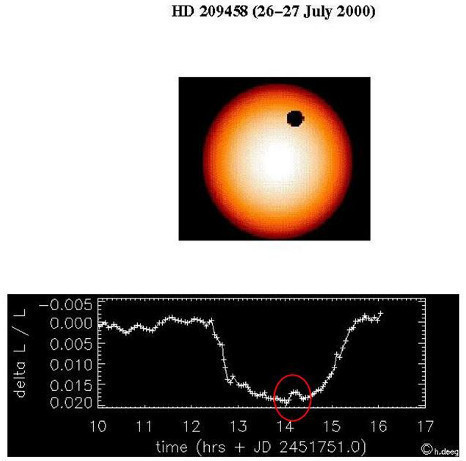
This method has already been applied to stars observed by the CoRoT and Kepler satellites. The same model that simulates the transit of a planet in front of its host star can be applied to the study of moons or rings of these planets. The results of the simulation showed that transits of moons and rings are detectable. Measurements of the duration and transit central time can present small variations caused by the movement of the planet around the center of mass of the planet and the moon.
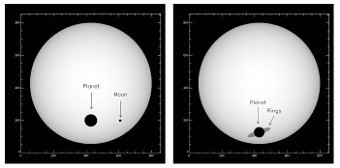
The global atmospheric electric circuit (GAEC) connects the separation of electric charges in regions with electrical disturbances, and electric currents are flowing in regions of fair weather. The circuit is closed by two electrically conductive media, the surface of the Earth and the base of the ionosphere. In the absence of a mechanism to maintain the 250 kV potential difference of the ionosphere with respect to the earth's surface, currents in fair weather regions should cease within a few minutes. Wilson (1920) suggested the hypothesis that storms could act as a generator, by electrically charging the base of the ionosphere and the earth's surface, thus maintaining the GAEC. In fact, there is a close correspondence between the Carnegie curve representing the daily variation of the fair-weather electric field measured over the oceans, and the daily variation of occurrence of storms. The GAEC is affected by the Sun and its activity, by geomagnetic activity, by cosmic rays, aerosols and pollution.
GAEC was also used to study short-term precursors of seismic activity. The main motivation for these studies is that nowadays, the emanation of excess Radon gas is an indisputable (perhaps the only one) observational evidence associated with seismic activity. As the decay of radon is the largest contribution to the ionization in the lower troposphere (up to 10 km), change in radon emanation system will modify the electrical conductivity near the surface of the earth, and thus will modify the value of the fair-weather electric field. These effects are difficult to observe because the electric field is extremely variable due to other phenomena such as storms, fog, dust, wind, rain, snow aerosols, and air pollution. One usually defines as fair-weather conditions parameters as: weather without precipitation (rain, snow, fog, fog, etc.), minimum cloud cover, wind speed < 6 m / s, no storm system within a radius of 75 km.
The main objectives of the continuous monitoring of the GAEC are: (i) obtaining Carnegie curves and evolution in function of the season, the solar activity cycle, the presence of solar and geomagnetic disturbances; (ii) relationship with seismic activity on the Pacific coast of Peru.
nvestigation of the Sun as star and its activity regimes. Sol calm, quiescent and active. Diagnoses obtained from observations carried out at an altitude observatory in the Argentinean Andes by means of an agreement with the El Leoncito Astronomical Complex (CASLEO, organ of CONICET, Argentina), with a sub-millimeter wave solar radio telescope (SST).
Operation of solar cosmic ray detector. Microwave radio polarimeter telescope (7 GHz) for solar patrol observations at CRAAM, SP. Research on solar atmosphere structure, formation of sun spots and confined plasmas in the associated active regions. Cycles of solar activity. The interplanetary environment and its variability by solar activity. Storage of energy in active regions and its release in the form of flares. Phenomenon of ejection of coronal masses. Physical mechanisms of acceleration of particles at high energies in accelerators and in magnetoactive solar plasmas.
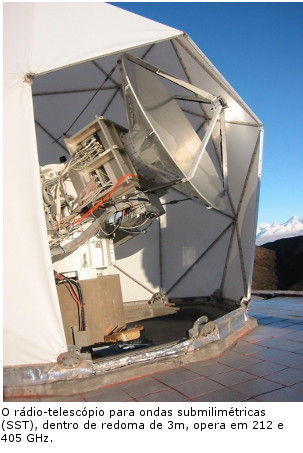

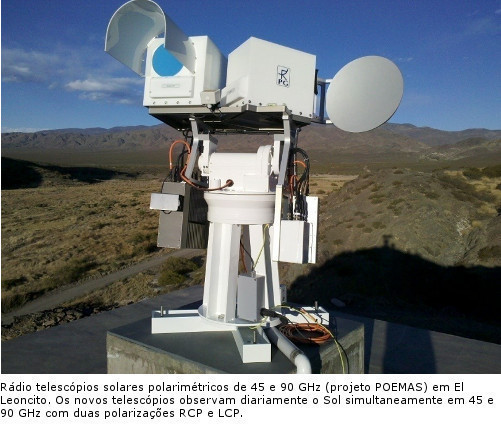
The high terrestrial atmosphere, ionosphere and plasmasphere. Diagnostics obtained through radio-scientific techniques (propagation of VLF signals, GPS, absorption of cosmic noise and ionosonde). Experimental researches with installation and operation of stations at various sites in Brazil, Argentina, Peru, Mexico and Antarctica.
Association of VLF propagation anomalies with solar and geophysical phenomena, and natural phenomena such as seismic events. Impacts on the planet by phenomena in outer space in the propagation of the signals, highlighting the effects by solar and cosmic explosions. Contents of free electrons in the ionosphere, in the plasmasphere and their diurnal, seasonal variation, and in the presence of solar activity, with measurements of GPS signals and absorption of cosmic noise in VHF. Low terrestrial atmosphere, troposphere, radiometric techniques for determination of precipitable water vapor content. Studies of the atmospheric electric field and its diurnal temporal variation (Carnegie curve), association with natural phenomena like lightning and seismic events. Propagation of millimeter and sub-millimeter waves (THz frequencies) in the troposphere. Influence of space weather on technological systems in space, including artificial satellites, and on Earth's surface.
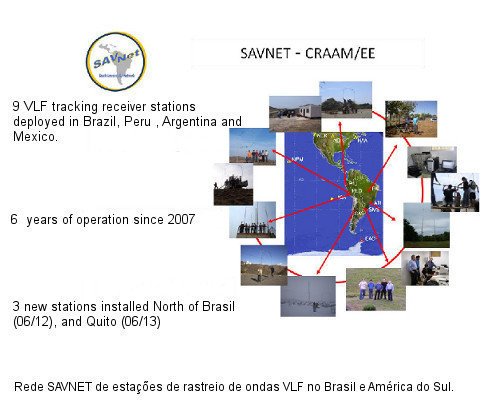

Very Long baseline interferometry (VLBI) applied to precision geodesy to measure irregularities in Earth's rotation, plastic movements of the planet and length of days. Regular operation of a 14.2 meter antenna of the Northeast Space Observatory Radio, Eusébio / Fortaleza, CE, integrated with the International VLBI Service (IVS) under a Mackenzie-NASA contract, Brazilian Space Agency agreement and cooperation with INPE.
Development and implementation of a pilot system for a new Brazilian geo-referencing system (Geomack) with applications for time synchronization in remote actuators (telephone repeaters, circuit breakers, precision agriculture devices, etc.), navigation and remote positioning.
Orbitography using the Geomack system. Determination of orbits of artificial satellites considering monogenic and polygenic forces and resonances. Satellite orbits orbiting planetary satellites.
Geographic Information System (GIS) and Digital Image Processing (PDI) applied to spatial analysis related to municipal management, urban and regional planning, transport engineering, environment, water resources, urban operations, environmental and urban public policies, analysis and warning of natural disasters, among other areas. Development of computational tools for geoprocessing and geo-positioning.
Development of computational algorithms and simulations for geo-positioning. Projects developed in the Laboratory of Geotechnologies of the School of Engineering of Presbyterian Mackenzie University. Internal cooperation with Civil Engineering and Architecture and Urbanism courses. Artificial satellite constellations. Cooperation with INPE and UNIFESP.

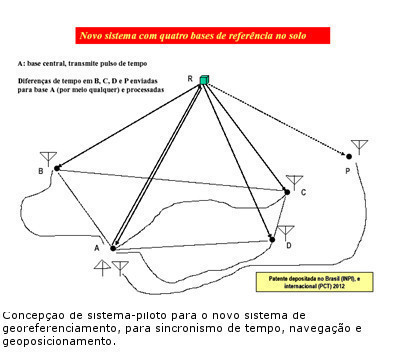
Technology of large antennas. Radio-propagation of millimeter and submillimeter waves. Solar radio astronomy in millimeter and submillimeter waves in the altitude laboratory El Leoncito Astronomical Complex. Operations of the Itapetinga Radio Observatory, Atibaia, SP, through a cooperation agreement with INPE, especially the radio telescope of 13.7 meters for millimeter waves, solar patrol in microwave and VLF tracking station.
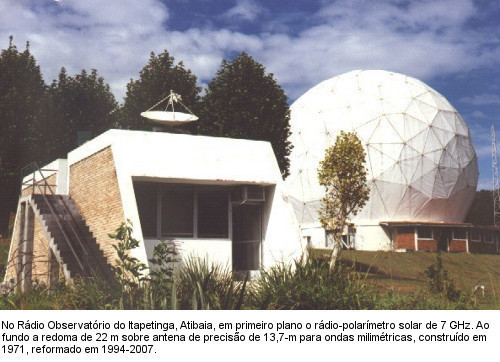
Research and development of sensor devices, materials and filters for mid and far infrared applications. Technology in the Terahertz range of frequencies. Applications for sensing activity in the solar disk.
Implementation of THz solar radiation photometers for operations on space platforms. Integration and use of a Terahertz space experiment built by CRAAM, called SOLAR-T, for missions for observations of solar flares with THz photometric systems onboard stratospheric balloons on long duration flights.
Development and implementation of a photometric telescope for ground-based solar observations at discrete THz frequencies, at very high altitude sites and low water vapor content (Chilean highlands, South Pole, etc.). Partnerships with CCS / UNICAMP, University of California at Berkeley and Santa Barbara, California, Lebedev Physical Institute in Moscow and National Institute of Radio Astronomy, USA. Development of multi-beam solar sub-THz camera to be coupled to the 12-meter antenna part of the Argentine-Brazilian Llama project. Collaboration with courses in Electrical Engineering and Materials Engineering at the Mackenzie School of Engineering.
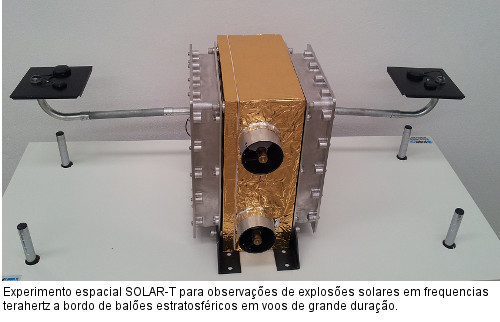
![Universidade Presbiteriana Mackenzie [Universidade Presbiteriana Mackenzie]](/fileadmin/CONFIGURACOES/DEFAULT_21/Resources/Public/Template/img/logo/universidade_mack_v2.svg)
